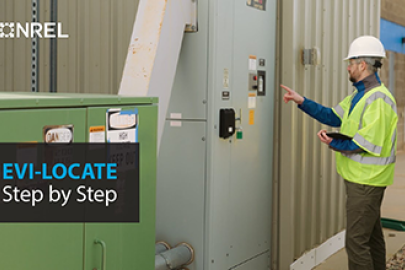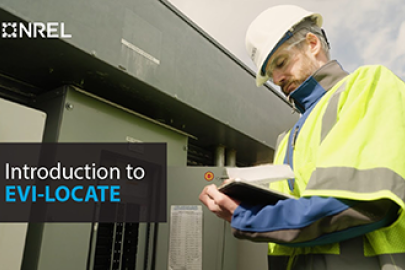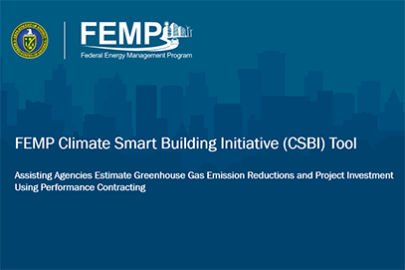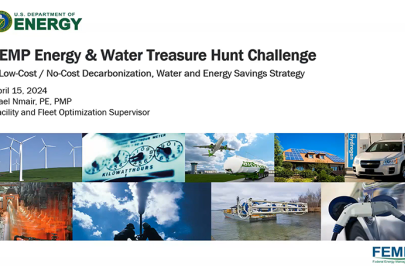The Electric Vehicle Infrastructure – Locally Optimized Charging Assessment Tool and Estimator (EVI-LOCATE) website guides you through an interactive site assessment process and generates cost estimates and site layouts for EV charging projects.
Federal Energy Management Program
June 14, 2024Electric vehicle (EV) charging station planning doesn’t have to involve guesswork. The Electric Vehicle Infrastructure – Locally Optimized Charging Assessment Tool and Estimator (EVI-LOCATE) website guides you through an interactive site assessment process and generates cost estimates and site layouts for EV charging projects. Learn more about EVI-LOCATE.
[music plays, people are talking loudly over one another]
Well, this is the best place to install an EV charging station here because people pull in right over here.
No no no no, the service panel is all the way over there.
Then let's just install a new one right over here.
It’s going to increase the cost to trench power all across this parking lot, and support...
No no no, I’ve got some new specs, and it's going to cost a lot less than we expected… so we can put a new service panel over there...
No no no no, we cannot have… we have to have the service panel power coming through here…
Let’s install a new one here. We can trench…
[music plays, narrator speaks]
Planning for electric vehicle chargers doesn't have to involve guesswork. The National Renewable Energy Laboratory has developed a new web tool to simplify and standardize the charging station design and cost estimation process. It's called EVI-LOCATE, or the Electric Vehicle Infrastructure – Locally Optimized Charging Assessment Tool and Estimator.
EVI-LOCATE is an online application that guides users through an interactive EVSE site analysis. You can plan out where your EV chargers will go. What kind of electrical upgrades you'll need to install, and how much it'll all cost. One benefit of electric vehicles is that they can charge when they sleep. Like your cell phone. But unlike your cell phone, EVs require a lot of power to charge. And how much power will you really need for your unique site?
EVI-LOCATE can do those calculations for you with an easy-to-use process tailored to your needs.
To start with, let's take a look at how EVI-LOCATE’s site assessment process works. First, you'll select your site's location and define a site boundary using Geographic Information System images. EVI-LOCATE helps determine the best location for charging stations by analyzing your site's unique landscape and energy infrastructure. Next, EVI-LOCATE helps estimate charger power requirements for your site. This includes your transformer and existing peak load, service panel capacity, and wiring and trenching needs.
We know that EV chargers can be expensive to install. EVI-LOCATE can help cut costs by determining the most cost-effective locations for charging stations and service panels. This saves costs by minimizing expensive trenches and backfilling.
[Nataleah Small, communications representative, National Renewable Energy Laboratory]
You don’t need to be an electrical engineer or be an EV charging expert to use this tool. You don’t even have to do any math. All you need to do is input some data into the site map, and then the tool will calculate the electrical capacity. Then you can figure out your project details and the cost of your project.
[narrator speaks]
How does it work? EVI-LOCATE was developed by utilizing the National Electrical Code, engineering calculations, geospatial processors, and the results of analyzing more than a thousand invoices of past EV charging projects. The National Electrical Code, known as NFPA 70, provides the tool with calculations on wire gauges and materials, as well as conduit trade sizes based on power requirements, distance covered, and ambient conditions. Engineering calculations determine the requisite capacity of the service transformers and service panels. Geospatial processors look at hardscape surfaces like asphalt and concrete, versus soft scape like grass or dirt.
This is an important consideration for installation costs, because trenching and backfilling hardscape is significantly more expensive than for softscape. A Geoprocessing algorithm then determines the least-cost path for running wires. NREL researchers compiled data from RSMeans and other sources to develop the initial cost estimates. Then they examined more than 1,000 invoices from real-world charging station installations to calibrate the results. The cost estimates account for differences in material and labor rates by ZIP code, and are specific to U.S. Department of Defense locations using the Army Corps of Engineers Base adjustment factors.
[Abdullah Hashmi, vehicle and infrastructure researcher, National Renewable Energy Laboratory]
A lot of data and research has gone into EVI-LOCATE’s development. While there is plenty going on behind the screens, all I really need to do is click through a few screens to plan my next project, and the tool does the rest.
[narrator speaks]
For a step-by-step tutorial on how to use EVI-LOCATE, watch the second video. Thanks for watching.
Watch the follow-up video, EVI-LOCATE Step by Step.
Learn more about FEMP's Fleet Electrification and Optimization program.










